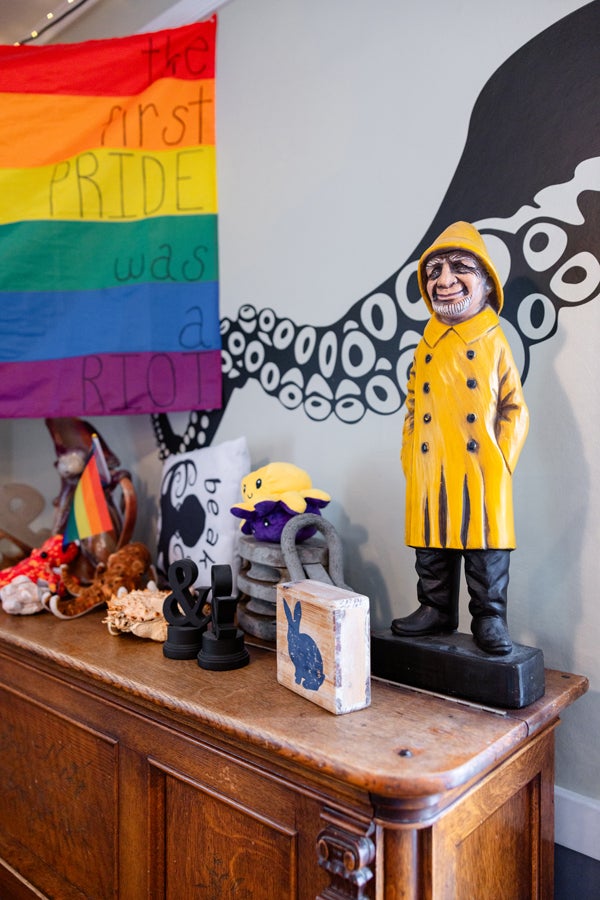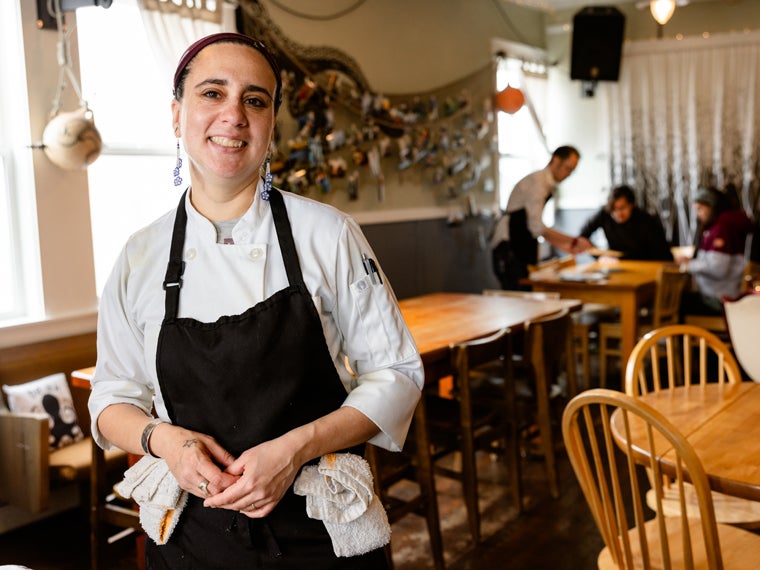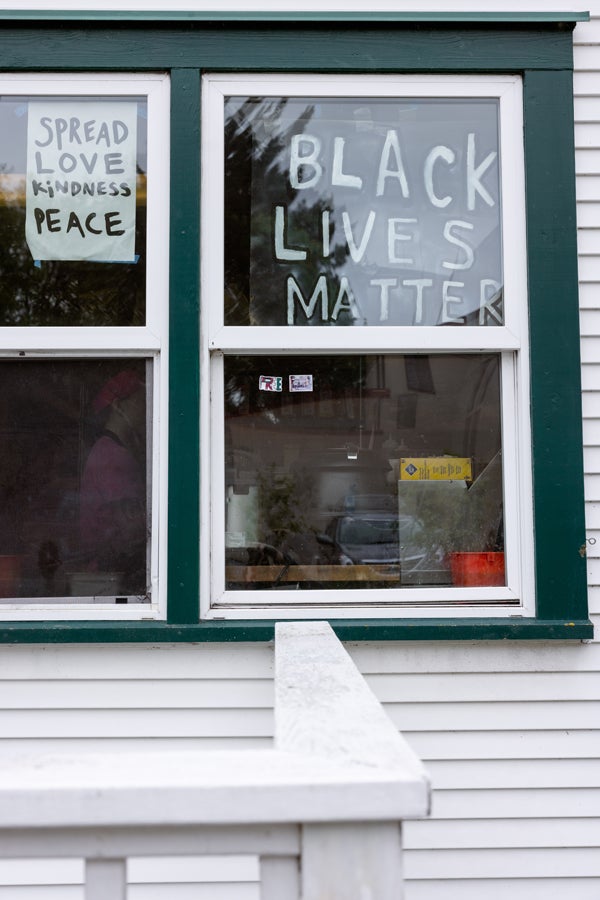Oberlin Alumni Magazine
The Power of Thinking Local
With Beak Restaurant, Renee Jakaitis Trafton ’07 is transforming the dining scene in Sitka, Alaska.
August 13, 2024
Hanna Raskin '98
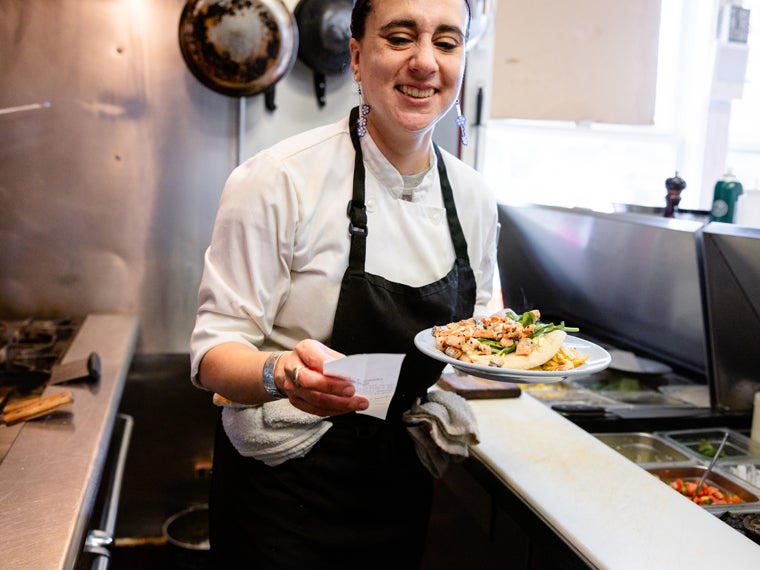
The mac and cheese that Beak Restaurant serves at both lunch and dinner is in some ways a departure from the Sitka, Alaska, bistro’s culinary precepts.
Certainly, the bowtie pasta is in keeping with the playful attitude that chef-owner Renee Jakaitis Trafton ’07 tries to cultivate in her kitchen. And Trafton’s staunch locavorism— which likely helped her become a semifinalist for Best Chef (Northwest and Pacific) at the 2023 James Beard Foundation restaurant awards—is evident in the optional upgrades: It costs $5 to accessorize the noodles with reindeer sausage or burly bits of blush pink salmon.

But on a menu dominated by dishes finished with little more than olive oil or soy sauce, the mac stands out for being sluiced with cheddar cheese.
Still, Trafton stresses she doesn’t use butter or heavy cream. “I want food that you can eat and feel fantastic afterward. I want food that makes you feel powerful.”
Trafton has focused on seizing and shifting power through food choices ever since she was a philosophy major at Oberlin. As she puts it on Beak’s website, “I am dedicated to putting employees first, even ahead of the guest. Without a team, there is no restaurant.”
Case in point: Beak opened in 2017 as a no-tipping restaurant as a way to arm her front-of-house workers with a consistent wage and liberate them from potential guest harassment.
“My female employees have the power to not be bothered by a guy being a jerk,” Trafton says.
“They’re not going to be financially penalized if they’re short with someone.”
Trafton’s commitment to teamwork has roots in her membership in the Oberlin Student
Cooperative Association. She initially oversaw OSCA’s tofu-making program, making sure a crew curdled and pressed soybeans every Sunday afternoon. Then she was elected lead dinner cook at Harkness Hall, a position she held for four semesters.
She credits the experience with determining her eventual career trajectory. “Majoring in philosophy, you can work on a paper for two hours and get two sentences,” she says. “If you’re working in the kitchen for two hours, you can feed your whole co-op, and people are happy. It’s really rewarding.”
As lead dinner cook, Trafton was charged with planning and sourcing ingredients for dinners. In one memorable instance, this included 7 grams of saffron that her mother brought back from her native Panama.
Although Trafton would later earn the affection of countless cruise passengers with her signature rockfish tacos, she didn’t include fish or shellfish in the massive paella she made with that saffron. Like many of her fellow Harkness residents, Trafton gave up eating meat while at Oberlin.
“Midway through my freshman year, thinking about my sense of agency in the world, I decided the food I put in my body was what I was going to focus on,” she says.
Her vegetarianism lasted until she moved to Ithaca, New York, after graduation with her classmate (now husband) Math Trafton. Working as a cook at two restaurants, she was often faced with leftovers that didn’t conform to her dietary restrictions. “We’d have all this grouper and steak, and we’d have to throw it out or eat it,” she says, adding, “I am still very intentional about the food I eat.”
While Trafton intended to sign up for culinary school at some point, she worked in restaurants for so long that culinary school students started doing their externships with her. By the time she moved to Sitka, where Math Trafton had been offered a job in the University of Alaska Southeast’s English department, she felt fully confident in her kitchen skills.

After relocating, Trafton cooked at a public school. But when a restaurant space in town became available, she enrolled in Oberlin’s LaunchU program to help bring about Beak.
At first, the restaurant was a tough sell to locals. They didn’t much care for the restaurant that Beak had replaced and couldn’t understand why they’d go out for seafood they could prepare cheaply at home. Yet Trafton insisted that Beak offered something new—namely, “a more nuanced way of cooking fish than the way you cook for yourself.”
Eventually, Trafton’s can-do attitude won over Sitka skeptics. But in the summer, most of Beak’s tables are booked by tourists arriving by cruise ship. Online raves for the restaurant originate from Orlando, Florida; Pearland, Texas; and Las Vegas.
According to Trafton, it’s not uncommon for those guests to preface their orders by saying, “This is my first time having salmon.”
That’s quite meaningful for Trafton. “Hopefully they’ll take the memory with them for a lifetime,” she says.
Along with the memory, of course, those satisfied diners leave knowing more about food and themselves. Some might even call that power.
Everything Encrusted Rockfish
On the menu since Trafton opened Beak, this dish uses rockfish, which is native to the Pacific from California to Alaska.
“There are about 30 different types and are not very sought after commercially,” Trafton says. “Often, they are bycatch from other fisheries. They sure are delicious, though.” She adds that while you can buy “everything mix” seasoning blends, she’s made her own for a long time. “Mine includes sunflower seeds, garlic, onion, poppy seeds, black sesame seeds, and white sesame seeds.”
Ingredients
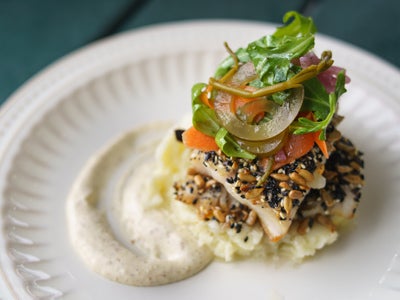
3 small red potatoes, diced
1 tablespoon butter
2 tablespoons heavy cream
¼ cup mayonnaise
1 teaspoon stone-ground mustard
1 egg
3 tablespoons flour
⅛ teaspoon milk
1 rockfish fillet, about 6 ounces, divided
2 tablespoons everything mix
Canola oil
Salt and pepper to taste
Pickled vegetables such as carrots, red onions, or bull kelp for garnish
Instructions
Heat oven to 400 degrees Fahrenheit.
Place diced potatoes in a saucepan with cold water to cover. Bring the water to a boil over high heat.
While the potatoes are cooking, combine the mayonnaise and mustard into an aioli in a small bowl. Refrigerate.
Once the potatoes are tender, drain and place in a bowl.
In a separate pan, slowly melt the butter over medium-low heat, stirring with a wooden spoon to prevent burning. Once melted, add the heavy cream.
Mash the potatoes, then add the butter and cream mixture to the bowl. Salt and pepper to taste. Set aside.
Make an egg wash by combining the egg, flour, and milk to form a medium-thick paste.
Place the two rockfish fillets on a plate. Season with salt. Using a pastry brush, brush the egg wash onto the fish. Sprinkle the everything mix on the fish.
Heat a heavy-bottomed skillet over medium heat. Add canola oil to coat the bottom. The oil should shimmer a bit, which indicates that the pan is hot enough.
Place the fish pieces in the skillet, everything mix side down. It should become fragrant, and you should be able to see the crust form a bit. Flip the fish with a fish spatula, taking care not to disturb the crust.
Transfer skillet to the oven for 4 to 6 minutes, depending on the thickness of the fillet.
To plate the dish, place a dollop of the aioli above the center of the plate. Drag the back of your spoon through it to make an appealing “swoosh.”
Below that, scoop a nice helping of the mashed potatoes. Flatten them slightly; the fish will rest on top.
Once the fish is done, carefully stack both pieces on top of the potatoes, pushing down slightly so they don’t fall over. Top with pickled vegetables if desired.
This recipe originally appeared in the Winter/Spring 2024 issue of the Oberlin Alumni Magazine in the story “Secret Sauce”.
https://www.oberlin.edu/news/power-thinking-local
Note: OAM publishes recipes as provided but doesn’t test them independently.
You may also like…
Coming Full Circle
Under Finney’s vaulted ceilings, the orchestra, several star vocal soloists, and the conservatory’s vocal ensembles—including the Oberlin College Choir, Oberlin Gospel Choir, and Oberlin Musical Union...
Treasure Hunting
A peek into the expansive world of Tony-winning costume designer Montana Levi Blanco '07.
The Body, The Host
An award-winning Allen Memorial Art Museum exhibition challenges the prevailing narrative of the 1980s HIV/AIDS epidemic.
